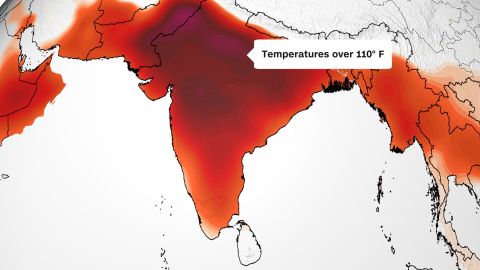Since the beginning of the summer season in March this year, heatwaves have been observed in huge regions of India. Throughout the previous two months, maximum temperatures in west Rajasthan and Vidarbha, Maharashtra, have been between 40 and 45 degrees Celsius. Despite the fact that March is traditionally the month when the seasons change from winter to summer, this year’s month had two heat waves. Since March, the country has seen four heat waves in an abnormally early summer.

Since the beginning of March, there have been at least 26 heatwave days and as many as four heatwave periods in just over a month and a half. The last of the heat waves is still going on. Kutch-Saurashtra, northern Konkan and Madhya Maharashtra, Rajasthan, Delhi, Punjab, Himachal Pradesh, Jammu, West Madhya Pradesh, West Uttar Pradesh, and inland Odisha were all impacted by the first of these, which lasted from March 11 to 19.
The next spell, which began on March 27 and ended on April 12, was particularly lengthy. It affected all of the areas affected by the previous heat wave, as well as Uttarakhand, Jharkhand, Chhattisgarh, Rayalaseema, and East Madhya Pradesh, spanning a considerable portion of the country’s north, west, and centre.
On April 17, a fresh heat wave began after a brief break of a few days. This lasted just for a few days, from April 20 to April 20, and it was mostly limited to Delhi, Rajasthan, East Uttar Pradesh, Bihar, and Vidarbha.
The fourth heat wave, which began on April 24 across Kutch-Saurashtra and Rajasthan, is still going strong. It is predicted to expand to Delhi, Haryana, Chandigarh, Punjab, Uttar Pradesh, Madhya Pradesh, Bihar, Gangetic West Bengal, Odisha’s interior, Chhattisgarh, northern Gujarat, and Vidarbha in the next days.
A heatwave is declared by the India Meteorological Department (IMD) when the highest temperature in a location hits at least 40 degrees Celsius in the plains, at least 37 degrees Celsius near the coast, and at least 30 degrees Celsius in mountainous areas.
A heatwave, on the other hand, is proclaimed when the maximum temperature climbs by 4.5 to 6.4 degrees Celsius over usual. When the highest temperature deviates from normal by more than 6.4 degrees Celsius, a severe heatwave is proclaimed.
A third criterion for a heatwave occurs when the highest temperature in a specific location exceeds 45 degrees Celsius and reaches 47 degrees Celsius on any given day.
Heatwaves are most common in the summer months of April-June, with May being the most severe and frequent.
Rajasthan, Punjab, Haryana, Chandigarh, Delhi, West Madhya Pradesh, Uttar Pradesh, Chhattisgarh, Orissa, Vidarbha in Maharashtra, sections of Gangetic West Bengal, Coastal Andhra Pradesh, and Telangana make up the Core Heatwave Zone (CHZ).
Heat waves can last anywhere from four to ten days, and sometimes much longer. Because of the lack of rainfall, heatwaves last longer in May than they do in April and June.
According to studies, the CHZ sees more than six heatwave days every year throughout the months of March to June.
Since March, several sections of the nation have been devoid of the customary light-intensity rainfall, hail, and lightning. In March, the country’s overall rainfall was minus 70.7 percent.
Since 1901, March 2022 has been India’s third hottest month. According to the IMD, the monthly high temperature was 32.65 degrees Celsius, compared to the usual of 31.24 degrees. Thunderstorms are usually triggered when passing western disturbances – the eastward spreading stream of winds originating from the Mediterranean Sea – meet with moist winds flowing from southern India. The gentle rain and thunder that come and go assist to keep the heat at bay.
The western disturbances have not been powerful enough this summer, according to IMD officials. Despite the fact that five western disturbances have been registered since March, three of them were weak and went over the country’s far north, failing to generate substantial meteorological changes, according to a senior IMD scientist.
April, on the other hand, has been rainy across the south peninsula and northeast India. As a result, these places have had a rather cold summer. During the period March 1-April 26, rainfall deviations from normal were 50.4 percent in the south peninsular and 49.7% in northeast India, respectively.
The summer of 2022 saw one of the longest heatwaves in recent memory over India. The last time the country saw sustained high temperatures was between May 18 and May 31, 2015, when regions of West Bengal, Odisha, Andhra Pradesh, and Telangana were affected. Between June 2 and June 11, 2014, another extended period was reported.
This scenario is unlikely to alter very soon. Rajasthan, Delhi, Haryana, Chandigarh, Madhya Pradesh, Vidarbha, Uttar Pradesh, Jharkhand, West Bengal’s interior, and Odisha could expect hotter weather till at least Sunday (May 1). The maximum temperature is forecast to climb by 2 degrees Celsius until May 1, after which it will gradually decrease.
The heat wave in Bihar and Chhattisgarh, on the other hand, will subside by April 30.
